Using Forms in Your Web Page
Please Note: This tutorial assumes you are thoroughly familiar with creating online fill-in forms, including HTML form design elements. Steps for successful form design
The ExampleBelow is a fairly detailed example form with a number of design elements, along with the HTML code used to create it. By copying this code and modifying the appropriate areas, you should be able to get your form up and running fairly quickly. First, here is the form: |
Parts of this code you will need to customise are hyperlinked to full explanations.
<!--================== Base form setup ====================--> <form action="http://www.albury.net.au/cgi-bin/forms/form_processor.cgi" method="post"> <input type="hidden" name="mailto" value="username@albury.net.au"> <input type="hidden" name="html_response" value="Previous"> <input type="hidden" name="email_subject" value="WWW Form Enquiry"> <input type="hidden" name="variable_order" value="name|company|address|email|ostype|colour|choc|straw|cara|van|comm"> <input type="hidden" name="url_of_this_form" value="http://www.albury.net.au/~username/"> <input type="hidden" name="required_variables" value="name|ostype"> <input type="hidden" name="background" value="your_image"> <input type="hidden" name="bgcolor" value="FFFFFF"> <input type="hidden" name="text_color" value="000000"> <input type="hidden" name="link_color" value="FF0000"> <input type="hidden" name="vlink_color" value="0000FF"> <input type="hidden" name="alink_color" value="00FF00"> <input type="hidden" name="response_title" value="Thank You!"> <input type="hidden" name="return_link_name" value="Return back previous page..."> <input type="hidden" name="return_link_url" value="http://www.albury.net.au/~username"> <input type="hidden" name="database_delimiter" value=","> <!--===================== End of form setup =======================--> Your Name: <input type="text" name="name" size="40"> <br> Company Name: <input type="text" name="company" size="40"> <br> Address: <input type="text" name="address2" size="40"> <br> email Address: <input type="text" name="email" size="40"> <br> The operating system you use: <select name="ostype"> <option>DOS</option> <option selected>Windows 95</option> <option>Windows NT</option> <option>BSDI</option> <option>Linux</option> </select> What is your favourite colour? <br> <input type="radio" name="colour" value="red" checked>Red <input type="radio" name="colour" value="green">Green <input type="radio" name="colour" value="blue">Blue What flavour ice cream do you like (you can select more than one): <br> <table><td width="110" align="left"> <input type="checkbox" name="choc" checked>Chcocolate<br> <input type="checkbox" name="straw">Strawberry<br> <input type="checkbox" name="cara">Caramel<br> <input type="checkbox" name="van">Vanilla<br> </td></table> Please enter any comments you may have:<br> <textarea name="comm" rows="10" cols="35"></textarea> <input type="submit" VALUE="Submit Details"> <input type="reset" VALUE="Reset Form"> </form>
The ExplanationThe form is controlled by the set of hidden fields contained in it. The data in these hidden fields must be altered to suit your particular site.
Final NoteFinally, don't forget to thoroughly and exhaustively test all aspects of your Web form. Follow all links, make sure that when data is submitted the right things happen. Make sure errors are generated in the right places. Check it all, then double check it. There's nothing more frustrating for your users than a Web page that won't do what it's told! |
